Deck 9: Project Scheduling: Networks, Duration Estimation, and Critical Path
Question
Question
Question
Question
Question
Question
Question
Question
Question
Question
Question
Question
Question
Question
Question
Question
Question
Question
Question
Question
Question
Question
Question
Question
Question
Question
Question
Question
Question
Question
Question
Question
Question
Question
Question
Question
Question
Question
Question
Question
Question
Question
Question
Question
Question
Question
Question
Question
Question
Question
Question
Question
Question
Question
Question
Question
Question
Question
Question
Question
Question
Question
Question
Question
Question
Question
Question
Question
Question
Question
Question
Question
Question
Question
Question
Question
Question
Question
Question
Question

Unlock Deck
Sign up to unlock the cards in this deck!
Unlock Deck
Unlock Deck
1/98
Play
Full screen (f)
Deck 9: Project Scheduling: Networks, Duration Estimation, and Critical Path
1
The longest route through the network is the __________.
critical path
2
__________ activities have two or more immediate predecessors.
Merge
3
Because an activity's pessimistic estimate may represent a much greater deviation from the most likely time than its optimistic estimate, the __________ better represents the distribution of possible alternative durations.
beta distribution
4
A merge activity has two or more immediate predecessors.

Unlock Deck
Unlock for access to all 98 flashcards in this deck.
Unlock Deck
k this deck
5
There is no slack on the project __________.

Unlock Deck
Unlock for access to all 98 flashcards in this deck.
Unlock Deck
k this deck
6
Float is always measured in exactly the same way as slack.

Unlock Deck
Unlock for access to all 98 flashcards in this deck.
Unlock Deck
k this deck
7
Activities that can be worked on simultaneously are __________ activities.

Unlock Deck
Unlock for access to all 98 flashcards in this deck.
Unlock Deck
k this deck
8
Hammock activities break a task into greater levels of detail so that each task is represented as two or more subtasks that each have their own duration and precedence requirements.

Unlock Deck
Unlock for access to all 98 flashcards in this deck.
Unlock Deck
k this deck
9
__________ activities can be used as summaries for some subsets of the activities identified in the overall project network.

Unlock Deck
Unlock for access to all 98 flashcards in this deck.
Unlock Deck
k this deck
10
Thanks to excessive dilly dallying, the subcontractor grossly exceeded the slack on his portion of the project, resulting in __________.

Unlock Deck
Unlock for access to all 98 flashcards in this deck.
Unlock Deck
k this deck
11
The late finish times are determined by taking a(n) __________ through the network.

Unlock Deck
Unlock for access to all 98 flashcards in this deck.
Unlock Deck
k this deck
12
In assigning a value for the most pessimistic (b) duration, the project manager should estimate the duration of the activity to have a 99% likelihood that it will take b or less amount of time.

Unlock Deck
Unlock for access to all 98 flashcards in this deck.
Unlock Deck
k this deck
13
A backward pass is performed when it is necessary to undo some work that has been performed in order to complete it properly.

Unlock Deck
Unlock for access to all 98 flashcards in this deck.
Unlock Deck
k this deck
14
You must know the mean of an activity in order to determine its standard deviation.

Unlock Deck
Unlock for access to all 98 flashcards in this deck.
Unlock Deck
k this deck
15
__________ is the identification of the project objectives and the ordered activity necessary to complete the project.

Unlock Deck
Unlock for access to all 98 flashcards in this deck.
Unlock Deck
k this deck
16
Preceding activities are those that must occur before others can be done.

Unlock Deck
Unlock for access to all 98 flashcards in this deck.
Unlock Deck
k this deck
17
__________ activities have two or more immediate successors.

Unlock Deck
Unlock for access to all 98 flashcards in this deck.
Unlock Deck
k this deck
18
Negative float exists when a project's critical path has been completed more quickly than anticipated.

Unlock Deck
Unlock for access to all 98 flashcards in this deck.
Unlock Deck
k this deck
19
The late start time should be calculated using a forward pass through the network.

Unlock Deck
Unlock for access to all 98 flashcards in this deck.
Unlock Deck
k this deck
20
Laddering is a technique that allows the project manager to redraw the network to more closely sequence project subtasks to make the overall network sequence more efficient.

Unlock Deck
Unlock for access to all 98 flashcards in this deck.
Unlock Deck
k this deck
21
An activity has an optimistic time estimate of 15 days, a most likely estimate of 24 days, and a pessimistic estimate of 40 days. What is the variance of the activity?
A) 4.17
B) 25.17
C) 17.36
D) 10.33
A) 4.17
B) 25.17
C) 17.36
D) 10.33

Unlock Deck
Unlock for access to all 98 flashcards in this deck.
Unlock Deck
k this deck
22
Which of these statements about this network is best? 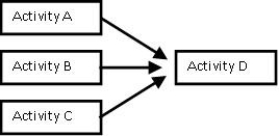
A) Activities A and B are serial activities.
B) Activities B and C are serial activities.
C) Activities A and C are serial activities.
D) Activity D is a merge activity.

A) Activities A and B are serial activities.
B) Activities B and C are serial activities.
C) Activities A and C are serial activities.
D) Activity D is a merge activity.

Unlock Deck
Unlock for access to all 98 flashcards in this deck.
Unlock Deck
k this deck
23
An activity with two or more immediate predecessors is a(n):
A) merge activity.
B) burst activity.
C) float activity.
D) event.
A) merge activity.
B) burst activity.
C) float activity.
D) event.

Unlock Deck
Unlock for access to all 98 flashcards in this deck.
Unlock Deck
k this deck
24
The term ordered activity means:
A) tasks must either precede or follow other tasks in project planning and management.
B) tasks cannot be performed unless the project manager issues a specific command to perform the work.
C) prior project planning removes the need for any rush so that tasks can be performed in a methodical fashion.
D) tasks are not performed unless the customer issues a specific request to perform the work.
A) tasks must either precede or follow other tasks in project planning and management.
B) tasks cannot be performed unless the project manager issues a specific command to perform the work.
C) prior project planning removes the need for any rush so that tasks can be performed in a methodical fashion.
D) tasks are not performed unless the customer issues a specific request to perform the work.

Unlock Deck
Unlock for access to all 98 flashcards in this deck.
Unlock Deck
k this deck
25
The variance of an activity is given by:
A) [1/6(b-a)]2.
B) 1/6[b-a].
C) [1/36(b-a)]2.
D) 1/36[b-a].
A) [1/6(b-a)]2.
B) 1/6[b-a].
C) [1/36(b-a)]2.
D) 1/36[b-a].

Unlock Deck
Unlock for access to all 98 flashcards in this deck.
Unlock Deck
k this deck
26
An activity has an optimistic time estimate of 15 days, a most likely estimate of 24 days, and a pessimistic estimate of 40 days. What is the expected duration of the activity?
A) less than 27 days but greater than or equal to 26 days
B) less than 26 days but greater than or equal to 25 days
C) less than 25 days but greater than or equal to 24 days
D) less than 24 days
A) less than 27 days but greater than or equal to 26 days
B) less than 26 days but greater than or equal to 25 days
C) less than 25 days but greater than or equal to 24 days
D) less than 24 days

Unlock Deck
Unlock for access to all 98 flashcards in this deck.
Unlock Deck
k this deck
27
The length of time expected to complete an activity assuming that its development proceeds normally is called the:
A) optimistic duration.
B) pessimistic duration.
C) most likely duration.
D) normal duration.
A) optimistic duration.
B) pessimistic duration.
C) most likely duration.
D) normal duration.

Unlock Deck
Unlock for access to all 98 flashcards in this deck.
Unlock Deck
k this deck
28
Network logic suggests that: 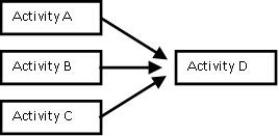
A) Activity D can start any time.
B) Activity A must be complete before Activity B can be done.
C) Activities A, B and C must be complete before Activity D can be done.
D) Activity C must begin before Activity B begins.

A) Activity D can start any time.
B) Activity A must be complete before Activity B can be done.
C) Activities A, B and C must be complete before Activity D can be done.
D) Activity C must begin before Activity B begins.

Unlock Deck
Unlock for access to all 98 flashcards in this deck.
Unlock Deck
k this deck
29
The least amount of float is found:
A) in a resource-limited schedule.
B) after a burst activity.
C) on the critical path.
D) after a merge activity.
A) in a resource-limited schedule.
B) after a burst activity.
C) on the critical path.
D) after a merge activity.

Unlock Deck
Unlock for access to all 98 flashcards in this deck.
Unlock Deck
k this deck
30
Concurrent activities are:
A) activities that must be done one after the other.
B) activities that can be performed at the same time.
C) activities that use labor from the same group of workers.
D) activities that use resources from the same resource pool.
A) activities that must be done one after the other.
B) activities that can be performed at the same time.
C) activities that use labor from the same group of workers.
D) activities that use resources from the same resource pool.

Unlock Deck
Unlock for access to all 98 flashcards in this deck.
Unlock Deck
k this deck
31
The amount of time an activity may be delayed from its early start without delaying the finish of the project is the:
A) delay.
B) float.
C) late start.
D) late finish.
A) delay.
B) float.
C) late start.
D) late finish.

Unlock Deck
Unlock for access to all 98 flashcards in this deck.
Unlock Deck
k this deck
32
Prior to creating a network, it is important to:
A) identify all loops through activities.
B) identify the party responsible for each activity.
C) calculate the float for each activity.
D) understand the activity precedence.
A) identify all loops through activities.
B) identify the party responsible for each activity.
C) calculate the float for each activity.
D) understand the activity precedence.

Unlock Deck
Unlock for access to all 98 flashcards in this deck.
Unlock Deck
k this deck
33
Ray's shipment of materials hit every red light and traffic jam on the way to the site. Upon arrival, half of the material was judged defective, necessitating a trip back to the supplier, and then the same arduous journey back to the site once the new materials were loaded. Traffic was a little better on the second round but the flat tire and subsequent repair caused as much if not more delay than the first trip. In the final analysis:
A) the project activity of Material Delivery was pretty close to the optimistic estimate.
B) the project activity of Material Delivery was pretty close to the most likely estimate.
C) the project activity of Material Delivery had a much higher variance than anticipated.
D) the project activity of Material Delivery was pretty close to the pessimistic estimate.
A) the project activity of Material Delivery was pretty close to the optimistic estimate.
B) the project activity of Material Delivery was pretty close to the most likely estimate.
C) the project activity of Material Delivery had a much higher variance than anticipated.
D) the project activity of Material Delivery was pretty close to the pessimistic estimate.

Unlock Deck
Unlock for access to all 98 flashcards in this deck.
Unlock Deck
k this deck
34
Based on the activity network pictured, what is the best statement? 
A) Activity C is a burst activity.
B) Activity E has one predecessor, Activity B.
C) Activity A and Activity C are merge activities.
D) There are no serial activities in this network.

A) Activity C is a burst activity.
B) Activity E has one predecessor, Activity B.
C) Activity A and Activity C are merge activities.
D) There are no serial activities in this network.

Unlock Deck
Unlock for access to all 98 flashcards in this deck.
Unlock Deck
k this deck
35
These can be located by doing a backward pass through a network.
A) critical paths
B) merge activities
C) successors
D) burst activities
A) critical paths
B) merge activities
C) successors
D) burst activities

Unlock Deck
Unlock for access to all 98 flashcards in this deck.
Unlock Deck
k this deck
36
What is the earliest that Activity D can begin if Activity A takes 3 days, Activity B takes 5 days, and Activity C takes 7 days? 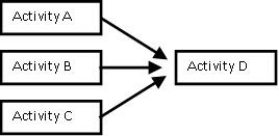
A) day 15
B) day 7
C) day 5
D) day 3

A) day 15
B) day 7
C) day 5
D) day 3

Unlock Deck
Unlock for access to all 98 flashcards in this deck.
Unlock Deck
k this deck
37
Based on the activity network pictured, what is the best statement? 
A) Before starting Activity C, Activity A, and Activity B must be completed.
B) Before starting Activity D, Activity A, and Activity B need to be completed.
C) Before starting Activity E, Activity A, and Activity B need to be completed.
D) Before starting Activity C, Activity A, and Activity D must be completed.

A) Before starting Activity C, Activity A, and Activity B must be completed.
B) Before starting Activity D, Activity A, and Activity B need to be completed.
C) Before starting Activity E, Activity A, and Activity B need to be completed.
D) Before starting Activity C, Activity A, and Activity D must be completed.

Unlock Deck
Unlock for access to all 98 flashcards in this deck.
Unlock Deck
k this deck
38
Serial activities are those that:
A) flow from one to the next in sequence.
B) have sequential numbers.
C) have the same numbers.
D) should be performed simultaneously.
A) flow from one to the next in sequence.
B) have sequential numbers.
C) have the same numbers.
D) should be performed simultaneously.

Unlock Deck
Unlock for access to all 98 flashcards in this deck.
Unlock Deck
k this deck
39
A sequence of activities defined by the project network logic is a(n):
A) event.
B) path.
C) node.
D) route.
A) event.
B) path.
C) node.
D) route.

Unlock Deck
Unlock for access to all 98 flashcards in this deck.
Unlock Deck
k this deck
40
One of the defining points of a network, a junction point joined to some or all of the others by dependency lines, is called a(n):
A) event.
B) path.
C) node.
D) burst.
A) event.
B) path.
C) node.
D) burst.

Unlock Deck
Unlock for access to all 98 flashcards in this deck.
Unlock Deck
k this deck
41
What is the late start time for Activity B given the activity times and precedence requirements shown in the table? 
A) 18
B) 9
C) 13
D) 5

A) 18
B) 9
C) 13
D) 5

Unlock Deck
Unlock for access to all 98 flashcards in this deck.
Unlock Deck
k this deck
42
Use the information in the table to determine the slack time for Activity B. 
A) 6 days
B) 4 days
C) 2 days
D) 0 days

A) 6 days
B) 4 days
C) 2 days
D) 0 days

Unlock Deck
Unlock for access to all 98 flashcards in this deck.
Unlock Deck
k this deck
43
What is the late start time for Activity E given the activity times and precedence requirements shown in the table? 
A) 12
B) 13
C) 14
D) 15

A) 12
B) 13
C) 14
D) 15

Unlock Deck
Unlock for access to all 98 flashcards in this deck.
Unlock Deck
k this deck
44
Activity Z has estimates a=5, b=10, m=7; activity X has estimates a=4, b=11, m=6; and activity Y has estimates a=3, b=12, m=8. Which of the following statements is best?
A) Activity X is longer than Activity Y.
B) Activity X has a higher standard deviation than Activity Z
C) Activity Z is shorter than Activity Y.
D) Activity Y has a smaller variance than Activity Z.
A) Activity X is longer than Activity Y.
B) Activity X has a higher standard deviation than Activity Z
C) Activity Z is shorter than Activity Y.
D) Activity Y has a smaller variance than Activity Z.

Unlock Deck
Unlock for access to all 98 flashcards in this deck.
Unlock Deck
k this deck
45
Use the information in the table to determine the late start time for Activity E. 
A) day 23
B) day 26
C) day 32
D) day 17

A) day 23
B) day 26
C) day 32
D) day 17

Unlock Deck
Unlock for access to all 98 flashcards in this deck.
Unlock Deck
k this deck
46
Use the information in the table to determine the early finish time for Activity D. 
A) day 23
B) day 26
C) day 29
D) day 32

A) day 23
B) day 26
C) day 29
D) day 32

Unlock Deck
Unlock for access to all 98 flashcards in this deck.
Unlock Deck
k this deck
47
An activity has a pessimistic time that is three times as long as its most likely time and five times as long as its optimistic time. If the activity variance is 10, what is the expected time?
A) about 10 days
B) about 14 days
C) about 19 days
D) about 23 days
A) about 10 days
B) about 14 days
C) about 19 days
D) about 23 days

Unlock Deck
Unlock for access to all 98 flashcards in this deck.
Unlock Deck
k this deck
48
Use the information in the table to determine the late finish time for Activity B. 
A) day 17
B) day 26
C) day 20
D) day 23

A) day 17
B) day 26
C) day 20
D) day 23

Unlock Deck
Unlock for access to all 98 flashcards in this deck.
Unlock Deck
k this deck
49
What is the late finish time for Activity D given the activity times and precedence requirements shown in the table? 
A) 14
B) 13
C) 12
D) 11

A) 14
B) 13
C) 12
D) 11

Unlock Deck
Unlock for access to all 98 flashcards in this deck.
Unlock Deck
k this deck
50
What is the early start time for Activity G given the activity times and precedence requirements shown in the table? 
A) 14
B) 15
C) 16
D) 17

A) 14
B) 15
C) 16
D) 17

Unlock Deck
Unlock for access to all 98 flashcards in this deck.
Unlock Deck
k this deck
51
What is the slack time for activity E? 
A) 1 day
B) 0 days
C) 2 days
D) 4 days

A) 1 day
B) 0 days
C) 2 days
D) 4 days

Unlock Deck
Unlock for access to all 98 flashcards in this deck.
Unlock Deck
k this deck
52
An activity has an optimistic time estimate of 7 days, a most likely estimate of 12 days, and a pessimistic estimate of 20 days. What is the expected standard deviation of the activity?
A) between 2 and 3 days
B) between 3 and 4 days
C) between 4 and 5 days
D) between 5 and 6 days
A) between 2 and 3 days
B) between 3 and 4 days
C) between 4 and 5 days
D) between 5 and 6 days

Unlock Deck
Unlock for access to all 98 flashcards in this deck.
Unlock Deck
k this deck
53
Use the network diagram and activity lengths in the nodes to determine the early start time for activity D. 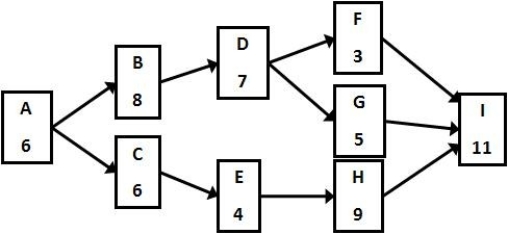
A) 8
B) 13
C) 14
D) 21

A) 8
B) 13
C) 14
D) 21

Unlock Deck
Unlock for access to all 98 flashcards in this deck.
Unlock Deck
k this deck
54
What is the early finish time for Activity F given the activity times and precedence requirements shown in the table? 
A) 17
B) 12
C) 13
D) 26

A) 17
B) 12
C) 13
D) 26

Unlock Deck
Unlock for access to all 98 flashcards in this deck.
Unlock Deck
k this deck
55
Use the information in the table to determine the early start time for Activity B. 
A) day 10
B) day 8
C) day 9
D) day 11

A) day 10
B) day 8
C) day 9
D) day 11

Unlock Deck
Unlock for access to all 98 flashcards in this deck.
Unlock Deck
k this deck
56
What is the slack time for Activity B given the activity times and precedence requirements shown in the table? 
A) 7
B) 6
C) 5
D) 4

A) 7
B) 6
C) 5
D) 4

Unlock Deck
Unlock for access to all 98 flashcards in this deck.
Unlock Deck
k this deck
57
What is the float start time for Activity C given the activity times and precedence requirements shown in the table? 
A) 1
B) 2
C) 3
D) 4

A) 1
B) 2
C) 3
D) 4

Unlock Deck
Unlock for access to all 98 flashcards in this deck.
Unlock Deck
k this deck
58
What is the early start time for Activity D given the activity times and precedence requirements shown in the table? 
A) 5
B) 9
C) 13
D) 18

A) 5
B) 9
C) 13
D) 18

Unlock Deck
Unlock for access to all 98 flashcards in this deck.
Unlock Deck
k this deck
59
An activity has an optimistic time estimate of 7 days, a most likely estimate of 12 days, and a pessimistic estimate of 20 days. What is the expected duration of the activity?
A) 13 days
B) 13.5 days
C) 12 days
D) 12.5 days
A) 13 days
B) 13.5 days
C) 12 days
D) 12.5 days

Unlock Deck
Unlock for access to all 98 flashcards in this deck.
Unlock Deck
k this deck
60
What is the slack time for Activity C given the activity times and precedence requirements shown in the table? 
A) 2
B) 1
C) 0
D) 3

A) 2
B) 1
C) 0
D) 3

Unlock Deck
Unlock for access to all 98 flashcards in this deck.
Unlock Deck
k this deck
61
There's an old saying, "The job is not finished until the paperwork is done." From an activity network standpoint, this does not necessarily mean that the paperwork can't begin until the last non-paperwork activity is completed. It might be possible to work on some paperwork as early activities are completed. In order to depict this in an activity network:
A) hammock activities could be drawn.
B) subroutines could be added.
C) shortcuts can be added to the network.
D) laddering could be used to redraw the network.
A) hammock activities could be drawn.
B) subroutines could be added.
C) shortcuts can be added to the network.
D) laddering could be used to redraw the network.

Unlock Deck
Unlock for access to all 98 flashcards in this deck.
Unlock Deck
k this deck
62
Use the network diagram and activity lengths in the nodes to determine the late finish time for activity C. 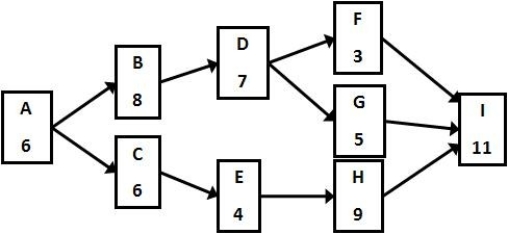
A) 12
B) 13
C) 14
D) 15

A) 12
B) 13
C) 14
D) 15

Unlock Deck
Unlock for access to all 98 flashcards in this deck.
Unlock Deck
k this deck
63
Use the network diagram and activity lengths in the nodes to determine the late start time for activity F. 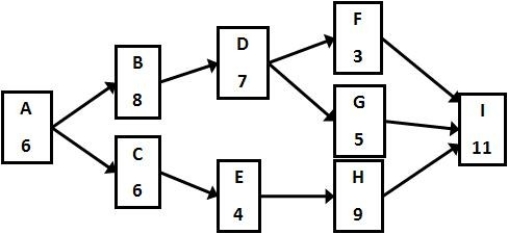
A) 21
B) 24
C) 26
D) 23

A) 21
B) 24
C) 26
D) 23

Unlock Deck
Unlock for access to all 98 flashcards in this deck.
Unlock Deck
k this deck
64
The overall effect of laddering activities is to:
A) streamline the linkage and sequencing between activities and keep project resources fully employed.
B) summarize some subsets of the activities identified in the overall project network.
C) allow the project team to disaggregate the overall project network into logical summaries.
D) allow the project manager to more fully deploy resources and complete the project with zero slack.
A) streamline the linkage and sequencing between activities and keep project resources fully employed.
B) summarize some subsets of the activities identified in the overall project network.
C) allow the project team to disaggregate the overall project network into logical summaries.
D) allow the project manager to more fully deploy resources and complete the project with zero slack.

Unlock Deck
Unlock for access to all 98 flashcards in this deck.
Unlock Deck
k this deck
65
A project has the precedence requirements and activity durations shown in the table. After he draws the network, the project manager decides that activities E and F can be represented by a hammock activity. What are the duration and the early start time associated with this hammock activity? 
A) 13, 36
B) 7, 0
C) 13, 7
D) 7, 14

A) 13, 36
B) 7, 0
C) 13, 7
D) 7, 14

Unlock Deck
Unlock for access to all 98 flashcards in this deck.
Unlock Deck
k this deck
66
Use the network diagram and activity lengths in the nodes to determine the early start time for activity D. 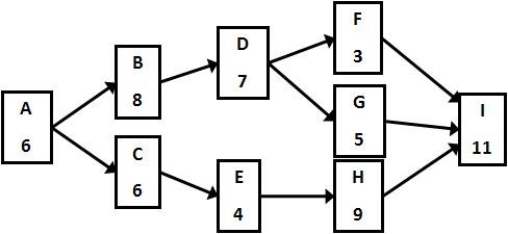
A) 8
B) 13
C) 14
D) 21

A) 8
B) 13
C) 14
D) 21

Unlock Deck
Unlock for access to all 98 flashcards in this deck.
Unlock Deck
k this deck
67
Activities C, D, and E in the project represented by the network are to be hammocked. What are the early start and late finish times of the hammock activity? 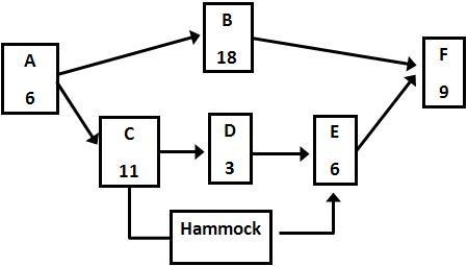
A) 6, 20
B) 6, 26
C) 9, 20
D) 9, 26

A) 6, 20
B) 6, 26
C) 9, 20
D) 9, 26

Unlock Deck
Unlock for access to all 98 flashcards in this deck.
Unlock Deck
k this deck
68
A project has the precedence requirements and activity durations shown in the table. After he draws the network, the project manager decides that activities B, C, and D can be represented by a hammock activity. What are the early start and late finish times associated with this hammock activity? 
A) 11, 30
B) 7, 24
C) 11, 24
D) 7, 36

A) 11, 30
B) 7, 24
C) 11, 24
D) 7, 36

Unlock Deck
Unlock for access to all 98 flashcards in this deck.
Unlock Deck
k this deck
69
Use the network diagram and activity lengths in the nodes to determine the slack time for activity D. 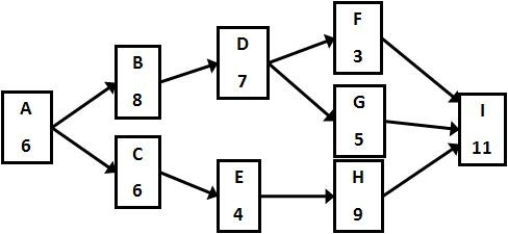
A) 3
B) 2
C) 1
D) 0

A) 3
B) 2
C) 1
D) 0

Unlock Deck
Unlock for access to all 98 flashcards in this deck.
Unlock Deck
k this deck
70
Activities C, D, and E in the project represented by the network are to be hammocked. What is the activity length of the hammock activity? 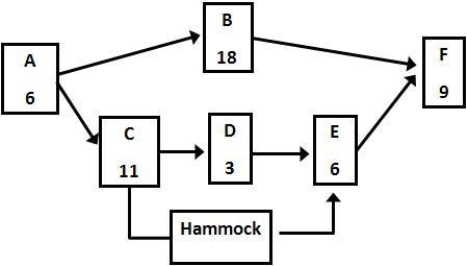
A) 20
B) 16
C) 13
D) 11

A) 20
B) 16
C) 13
D) 11

Unlock Deck
Unlock for access to all 98 flashcards in this deck.
Unlock Deck
k this deck
71
One approach to reducing project length would be to:
A) convert parallel paths to be serial.
B) convert merge activities to burst activities.
C) use hammock activities in place of multiple activities.
D) eliminate tasks on the critical path.
A) convert parallel paths to be serial.
B) convert merge activities to burst activities.
C) use hammock activities in place of multiple activities.
D) eliminate tasks on the critical path.

Unlock Deck
Unlock for access to all 98 flashcards in this deck.
Unlock Deck
k this deck
72
Use the network diagram and activity lengths in the nodes to determine the early finish time for activity G. 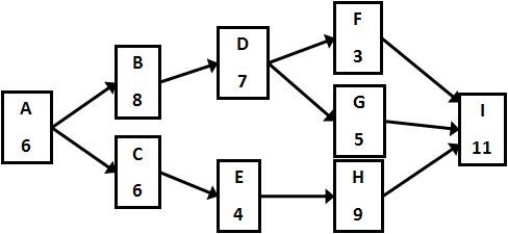
A) 26
B) 25
C) 24
D) 23

A) 26
B) 25
C) 24
D) 23

Unlock Deck
Unlock for access to all 98 flashcards in this deck.
Unlock Deck
k this deck
73
A project has the precedence requirements and activity durations shown in the table. After he draws the network, the project manager decides to represent a few activities by as hammock activity. Which is a legitimate hammock activity for this project? 
A) combine activities A, B, C
B) combine activities B, E, H
C) combine activities E, F
D) combine activities G, H, I

A) combine activities A, B, C
B) combine activities B, E, H
C) combine activities E, F
D) combine activities G, H, I

Unlock Deck
Unlock for access to all 98 flashcards in this deck.
Unlock Deck
k this deck
74
Project Test Bank is composed of activities we will refer to as A, B, C, and D for convenience (and lack of creativity). Durations and precedence requirements are shown in the table. Each of these activities can be conveniently laddered into two sub-activities of equal duration. The first half of each activity serves as the predecessor to its second half and the first half of the original following activity. What is the expected completion time of the laddered project? 
A) 34
B) 38
C) 42
D) 48

A) 34
B) 38
C) 42
D) 48

Unlock Deck
Unlock for access to all 98 flashcards in this deck.
Unlock Deck
k this deck
75
Activities C, D, and E in the project represented by the network are to be hammocked. What are the late start and early finish times of the hammock activity? 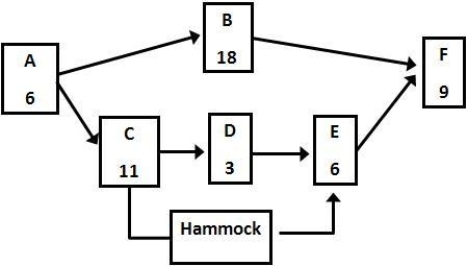
A) 6, 24
B) 6, 26
C) 8, 24
D) 8, 26

A) 6, 24
B) 6, 26
C) 8, 24
D) 8, 26

Unlock Deck
Unlock for access to all 98 flashcards in this deck.
Unlock Deck
k this deck
76
Project Test Bank is composed of activities we will refer to as A, B, C, and D for convenience (and lack of creativity). Durations and precedence requirements are shown in the table. Each of these activities can be conveniently laddered into two sub-activities of equal duration. The first half of each activity serves as the predecessor to its second half and the first half of the original following activity. What is the expected completion time of the laddered project? 
A) 34
B) 38
C) 42
D) 48

A) 34
B) 38
C) 42
D) 48

Unlock Deck
Unlock for access to all 98 flashcards in this deck.
Unlock Deck
k this deck
77
Hammock activities allow:
A) project managers to streamline the linkage and sequencing between activities.
B) project workers to effectively skip nonessential activities without compromising project quality.
C) the project team to better disaggregate the overall project network into subsets.
D) the project manager to identify float more quickly and leverage it more successfully for the overall success of the project.
A) project managers to streamline the linkage and sequencing between activities.
B) project workers to effectively skip nonessential activities without compromising project quality.
C) the project team to better disaggregate the overall project network into subsets.
D) the project manager to identify float more quickly and leverage it more successfully for the overall success of the project.

Unlock Deck
Unlock for access to all 98 flashcards in this deck.
Unlock Deck
k this deck
78
Summaries for some subsets of the activities identified in the overall project network are called:
A) ladder activities.
B) hammock activities.
C) negative float activities.
D) compressed activities.
A) ladder activities.
B) hammock activities.
C) negative float activities.
D) compressed activities.

Unlock Deck
Unlock for access to all 98 flashcards in this deck.
Unlock Deck
k this deck
79
A project has the precedence requirements and activity durations shown in the table. After he draws the network, the project manager decides that activities H and I can be represented by a hammock activity. What are the early start and late finish times associated with this hammock activity? 
A) 13, 36
B) 13, 24
C) 24, 36
D) 7, 36

A) 13, 36
B) 13, 24
C) 24, 36
D) 7, 36

Unlock Deck
Unlock for access to all 98 flashcards in this deck.
Unlock Deck
k this deck
80
Project Test Bank is composed of activities we will refer to as A, B, C, and D for convenience (and lack of creativity). Durations and precedence requirements are shown in the table. Each of these activities can be conveniently laddered into two sub-activities of equal duration, so activity C in the original project becomes two activities, C1 and C2, each of which last 7 days. The first half of each activity serves as the predecessor to its second half and the first half of the original following activity. What is difference in the late start time for activity C in the original project and activity C1 in the laddered project? 
A) 3
B) 5
C) 7
D) 9

A) 3
B) 5
C) 7
D) 9

Unlock Deck
Unlock for access to all 98 flashcards in this deck.
Unlock Deck
k this deck



